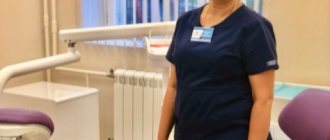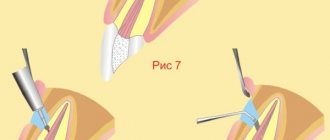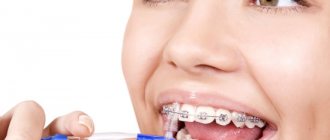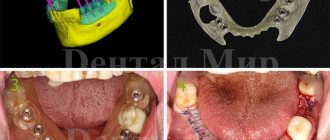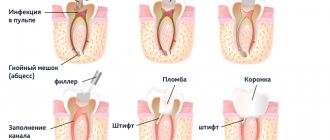2747
Preparation is a dental procedure that is based on grinding down a damaged tooth.
A manipulation is carried out to create additional space, which will then be used for the installation of an orthopedic structure.
Grinding is a mandatory procedure, without which it is impossible to properly fix the prosthetic structure.
The essence and purpose of the procedure
During turning, the surface layer of enamel is removed using special equipment equipped with high-speed burs with diamond tips.
Only with an ideally processed dental surface will the installation of the prosthesis be accurate and tight, which, in turn, will allow further avoidance of its rejection or the development of complications.
During preparation, the tooth is prepared for its further restoration. It takes on a cone-shaped shape (which simplifies the placement of the product), the remains of the carious cavity and old fillings are eliminated.
The procedure is considered by patients to be one of the most unpleasant in dentistry, so many of them do not decide to undergo prosthetics and end up losing their teeth.
But today, preparation technology has changed somewhat. The advent of new devices has made it possible to improve the technique, so there is virtually no pain or discomfort.
In addition, local anesthetics are used, which reduce the level of human sensitivity.
Treatment of caries
Everyone is accustomed to the fact that when visiting a dentist to treat caries, the doctor first drills the tooth for a long time, then puts a filling, after which he sends the patient home with peace of mind. Since many patients are very afraid of dentists and especially the sound of a drill, they often ask: “Is it possible not to drill a tooth?” It is impossible, both when treating caries and when grinding teeth.
The fact is that caries is a disease that affects not only the upper layer of enamel, on which a carious cavity is visible, but also the lower layers, which pathogenic microorganisms penetrate throughout. Before placing a filling, it is necessary to remove all existing infected tissue, which the doctor achieves by dissection.
If at least something remains, then a recurrence of caries will occur under the filling, which is often fraught with pulpitis - infection and inflammation of the nerve, which causes severe pain in the tooth.
Indications
The procedure is required in almost all cases when restoration is carried out in the oral cavity, namely:
- To restore or replace worn-out filling material;
- When reconstructing a dental element after a fracture;
- To correct a congenital defect of the coronal part;
- When installing veneers, crowns, etc.;
- To carry out other restoration activities as one of its stages.
Preparation is also necessary if caries is discovered during the removal of the enamel layer.
In this case, to prevent the spread of pathogenic microorganisms to neighboring units, carious tissue and infected dentin are removed.
Rules for the use of glass ionomer cement for fixation of crowns and bridges, composition and properties of the material.
Come here if you are interested in reviews about ceramic inlays for teeth.
At this address https://www.vash-dentist.ru/protezirovanie/nesemnyie-p/koronki-np/nuzhno-znat-o-titanovyih.html together we will calculate the price of titanium crowns for teeth.
Theoretical foundations of tooth preparation for fixed denture structures
Preparation of hard dental tissues is the process of mechanically removing damaged, non-viable or interfering with prosthetic hard tissues of the tooth. Dissection is one of the most frequently used medical procedures during an orthopedic appointment.
Tooth preparation is an operation performed on the hard tissues of the tooth with rotating instruments in order to give it the necessary shape for the manufacture of a specific type of fixed orthopedic structure. Preparation of hard dental tissues should be considered as a complex, traumatic effect, accompanied by pain reactions, certain morphological changes and restructuring of dental tissues, sometimes very unsafe for dental tissues.
At the preparation stage, the doctor is given the following tasks: • removing the volume of hard tooth tissue in order to create the necessary space for the material of the future prosthesis;
• formation of the optimal geometric shape and microrelief of the surfaces of the tooth stump or cavity for an inlay, veneer, crown, pin structure ensures reliable fixation of the prosthesis.
When planning the volume of preparation, it is necessary to take into account: • morphology and anatomy of the tooth;
• occlusal interaction and function;
• the material used to make the prosthesis;
• possible long-term consequences.
Preparation is a labor-intensive work operation, therefore, during this clinical stage, ergonometric factors are of great importance: • operating condition of the equipment (dental unit, chair, handpieces);
• position of the patient and position of the doctor;
• quality and quantity of instruments for preparation;
• availability of consumable disposable protective equipment for the patient and doctor, means for pain relief;
A combination of optimal ergonomic solutions creates a calm atmosphere during the work process and helps reduce the time and effort required to complete this clinical stage.
The painlessness of the procedure at the stages of hard tissue preparation can be ensured by: • anesthesia;
• quality of cutting tools;
• technique and modes of preparation;
• knowledge of the topography of the tooth cavity and safety zones.
In all cases where medical manipulations are associated with the appearance of a pain reaction in the patient, pain relief is indicated.
An important point in preparation tactics is the choice of the correct preparation mode, which consists in the ratio of the rotation speed of the abrasive tool, the pressure of the tool on the tooth being prepared and the time of contact of the tool with the tooth tissue.
Currently, various types of turbine dental units with adjustable speed of rotation of the tip of the abrasive tool are used to prepare teeth. Modern turbine handpieces can give the cutting tool rotation speeds from 300,000 to 500,000 rpm. However, when preparing teeth, you should not reach maximum speed: the speed of preparation should be compensated by working with high-quality and sharp instruments under air-water cooling. The rotation speed of the micromotor shaft ranges from 20,000 to 70,000 rpm. Taking into account the differences in the mechanical properties of hard dental tissues and the different speed capabilities of the tips, turbine tips are recommended for use when grinding enamel; micromotor turbines, as well as electric ones, when preparing dentin, using special raising tips in a ratio of 1÷5, while the rotation speed of the bur is commensurate with the turbine tip.
During the preparation process, tooth tissue is adversely affected by the heat generated during the operation of cutting instruments, which can cause inadequate dehydration of dentin. The risk of overheating of tooth tissue increases as the number of revolutions, pressure, and diameter of the working tool increases. However, the speed of rotation is probably not as important as the pressure exerted on the rotating instrument during preparation. The heat generated during preparation increases significantly if worn, dull cutting instruments are used.
The effect of these factors can be minimized by using the technique of intermittent preparation with minimal pressure on the tooth tissue of a sharp abrasive instrument with appropriate cooling, especially at high speeds of rotation of the abrasive.
In this regard, the painlessness, quality and efficiency of the dentin preparation process depend on the preparation regimen, the components of which are:
• rotation speed and torque value of the micromotor: when preparing hard dental tissues, the rotation speed should be at least 16,000 rpm, but not more than 30,000; when grinding tooth tissue in the cervical area, it is recommended to reduce the number of revolutions to
• the pressure of the abrasive tool on the tooth being prepared should be average in value and not exceed 200 g/mm (increasing pressure leads to increased heating of tissues: when using diamond tools, the temperature increase can reach 225-257 ° C, when using metal ones - 300-320 ° WITH);
• the optimal time for continuous preparation (time of contact of the instrument with the tooth tissue) should not exceed 3 s;
• tool vibration increases with increasing rotation speed and bur pressure on the tooth;
• supply of water cooling at a water temperature of no higher than 35 °C and in an amount of at least 50 ml/min.
Thus, a high-quality selection of instruments and a competent choice of preparation mode affect the painlessness of the procedure and can significantly reduce the influence of adverse factors during and after grinding of hard dental tissues.
Grinding of hard tissues must be carried out taking into account the topography of the tooth cavity and safety zones for each group of teeth, which ensures a painless procedure and the prevention of possible complications in the future.
Before starting preparation, it is advisable to determine the topography of the tooth cavity using an x-ray. However, it should be taken into account that x-rays allow one to study the structure of the tooth cavity only in the projection of the image. Therefore, additionally at the stages of preparation, it is advisable to use tables describing the parameters of the thickness of the hard tissues of the tooth from the outer surface of the crown to the wall of the tooth cavity.
Safety zones are areas of tooth crowns within which hard tissue can be excised without fear of opening the tooth cavity. Dangerous zones are considered to be those areas where only economical excision of hard tissues can be carried out due to their small thickness and proximity to the tooth cavity.
According to N.G. Abolmasova and E.I. Gavrilov, the safety zones of the incisors of the upper and lower jaws are located at the cutting edge, on the oral and vestibular surfaces - at the level of the equator and neck of the teeth. The most dangerous areas during preparation of incisors are the oral concavity of the crown between the dental tubercle and the cutting edge, as well as the contact surfaces at the level of the equator and neck, where they are thinnest.
In the canines of both jaws, the following are safe: the cutting edge, to a lesser extent – the vestibular, oral and contact surfaces at the level of the equator, the vestibular and oral – at the level of the neck. The danger zones are the oral concavity of the crowns and the medial contact wall at the level of the cervix; in the lower canines, the distal wall at the level of the cervix. With age, the safety zones of the entire group of anterior teeth expand more at the cutting edge and less on the oral surface at the equator and in the cervical area.
The study of the topography of the tooth cavity and the thickness of the walls made it possible to identify safety zones for premolars and molars, whose chewing surfaces are much thicker than all others.
In patients aged 20-24 years, the safety zones of the upper premolars are located on the chewing surface at the tops of the cusps and along the media-distal fissure. On the oral, vestibular and contact surfaces they are located at the level of the equator, in the cervical region - on the oral and vestibular surfaces. For lower premolars, the safety zone at the cervical level extends to the distal contact surface.
The oral slope of the buccal tubercle and the contact walls at the level of the neck have the smallest thickness in the premolars of the upper jaw; in the premolars of the lower jaw - the oral slope of the buccal tubercle and the mesial contact surface at the level of the neck. These areas are the most dangerous when preparing teeth.
With age, the thickness of all premolar walls, with the exception of the cusps, increases, i.e. security zones are expanding. On the tubercles, the thickness of the layer of hard tissue decreases with age, and with a pronounced process of abrasion, this area of the chewing surface after 40 years becomes a dangerous zone, which should be taken into account during preparation. Preparation should be carried out in compliance with the principle of economical grinding of hard tissues.
Grinding of hard dental tissues should be carried out within the limits dictated by the design of the prosthesis, and taking into account the type of tooth being processed - clinically intact or with a destroyed coronal part.
In cases where a crown is made on a clinically intact tooth, the preparation is carried out in such a way that the shape of the tooth stump repeats its original anatomical structure. When the coronal part of a tooth is destroyed, preparation should be carried out taking into account the individual characteristics of the anatomical structure of teeth of the same type for each patient or taking into account the average statistical parameters for teeth of a given type.
Excessive excision of hard tissue can lead to mechanical weakening of the supporting tooth, a decrease in the retention area, weakening of the fixing properties of cements, and in some cases cause inflammation or necrosis of the dental pulp. The thinner the layer of remaining dentin and the larger the surface area of damaged (exposed) dentinal tubules, the greater the risk of damage to the dental pulp. After preparation, the dentin layer surrounding and protecting the pulp must be at least 0.6 mm thick.
Preparation must be carried out taking into account biological factors, which include:
• protection of hard and soft tissues, as well as the adjacent periodontium, not only during the tooth preparation operation, but also at the stages of prosthetics and after fixation of the finished prosthesis, i.e. during its operation;
• ensuring optimal design contacts:
– with gum tissue;
– gingival papillae and adjacent teeth;
To eliminate or reduce the risk of damage to periodontal tissues of abutment teeth, the gingival boundaries of the preparation are of great importance.
The presence of a clear boundary of the preparation area is the main condition for ensuring the tightness of the marginal fit of the crown, which prevents mechanical irritation or traumatic damage to periodontal tissues due to an excessively long, sharp or overhanging edge of the crown. In this regard, it is recommended to prepare the teeth to the gum or in such a way that the edge of the crown is minimally immersed in the periodontal groove.
Safety precautions at the stages of preparation of hard dental tissues Preparation of hard dental tissues should be carried out in compliance with safety precautions when the doctor manipulates cutting instruments:
• before starting work, it is necessary to check the condition of the dental unit, test switch on the drill, handpiece (worn tips cause eccentric vibrations and vibration of the cutting tool), reliability of fixation of the cutting tools in the handpiece;
• for work, use a well-centered, highly abrasive cutting tool;
• good lighting of the surgical field must be provided;
• it is necessary to make sure that the patient’s head is fixed on the headrest and that the doctor’s position near the chair provides a good overview of the surgical field and allows the hand with the handpiece to be securely fixed;
• preparation of hard dental tissues should be carried out with the doctor’s full concentration on the manipulation being performed;
• the drill should be turned on only after inserting the tip with the instrument into the patient’s oral cavity and fixing the hand holding it;
• when working with a cutting instrument, the soft tissues of the oral cavity must be protected from damage using a dental mirror;
• the rotation speed of the drill must correspond to the purpose of the operation being performed;
• preparation should be carried out in a gentle manner, observing the principles of painless manipulation, economical co-grinding of hard tissues in a certain sequence;
• in order to prevent injury to the mucous membrane of the lips and cheeks, the cutting instrument should be removed from the oral cavity only after it has completely stopped.
Techniques
Not long ago, a special drill was used to treat problem units. Today, grinding technology has improved significantly.
Several new techniques have been developed that have made the manipulation more comfortable, as painless and safe as possible:
Ultrasonic
Grinding occurs using ultrasonic waves , which are emitted by a high-precision device. The advantages of the procedure include:
- absence of negative feelings;
- minimal risk of damage to hard tissues;
- pulp safety;
- painlessness;
- no heating of dentin and enamel.
Laser
This technique is based on the process of heating water in dental tissues using a pulsed laser. Its effect allows you to easily remove the affected areas with an air-water flow.
The advantages are considered to be high precision of processing, silent operation of the device, absence of damage and heating of tissues.
Disadvantages - there is a minimal risk of infection, the technique can only be used for surface treatment.
Air abrasive
Here, instead of a drill, a mixture of abrasive substance and air is used , supplied under pressure. This force is enough to remove the required amount of enamel and dentin.
The advantages of the technique are:
- safety;
- speed of manipulation;
- minimal heating of tissues;
- processing accuracy;
- no vibration;
- preservation of the maximum volume of healthy tissue;
- painlessness.
But at the same time, air abrasive grinding cannot be used as an independent technique due to the fact that it can only act on surface layers.
Can be used in combination with other methods of preparing teeth for prosthetics.
Chemical
Preparation involves the use of chemically active substances (for example, acids), which, through their action, soften the desired area of enamel.
The positive aspects of the technique are painlessness, safety for healthy tissues, and the absence of heating.
The only drawback is the length of the process (on average, it takes about 30 minutes to process one unit).
Tunnel
This technique is the most common due to its ease of implementation and the ability to accurately control the thickness of the surface being removed.
It is carried out using a special diamond tip (or metal) with high rotational ability.
The only advantage of tunnel preparation is the high precision of processing.
The method has significantly more disadvantages:
- strong heating of the enamel;
- need for pain relief;
- high probability of tissue damage;
- there is a risk of infection.
It is impossible to single out the best method from the entire list. All of them are selected individually for each patient , based on the condition of the oral cavity, examination results, and in accordance with the specific type of defect.
Types of ledges
A ledge is the part of hard tissue remaining after preparation on which the future prosthetic structure is planned to be secured. There are three varieties of it:
- Rounded . Used under metal-ceramic prosthesis. Allows you to preserve the maximum amount of hard tissue. Thickness varies from 0.8 to 1.3 mm.
- Knife-shaped. Designed for solid metal crowns. Ideal for turning inclined pieces. The width ranges from 0.3 to 0.5 mm.
- Brachial. It is the most reliable and durable when securing orthopedic products, but is uneconomical in terms of removing a large volume of tissue. The width is about 2 mm. Requires removal of the nerve from the tooth (depulpation).
If you do not create a ledge before prosthetics, the quality of the fit of the prosthesis will decrease significantly. This circumstance complicates oral care and increases the likelihood of developing recurrent caries.
Tooth preparation
Since there is no need to change the proportions and position of the incisors, tooth preparation can be carried out based on the initial situation. Color changes will only be made for 1.1. Guide lines are designed for minimally invasive preparation.
Preparation at the gum level
As a first step, I prepare outside the sulcus without any retraction. A prerequisite is healthy tissue surrounding the tooth.
Rice. 5 - Preparation from the proximal sides was also made at the level of the gum, following the contour of the gingival papilla.
Rice. 6 - Therefore, the next step is to move the preparation margin subgingivally under careful control without disturbing the biological width.
Installation of retraction thread
I place the first thread, which fills half of the gingival sulcus. Installation of a retraction cord provides vertical retraction .
How deep under the gum should I prepare? Based on data from J. Kois and F. Spear, there are two rules:
- If the probing depth is 1.5 mm or less, the boundary is lowered to a level of 0.5 to 0.7 mm.
- If the probing depth is greater than 1.5 mm, the border is lowered to half the depth of the furrow.
Those. if the probing depth is 1 mm, preparation is made 0.5 mm under the gum, and with a depth of 2 mm - 1 mm under the gum.
Therefore, the answer to the question: “Which retraction cord should I use?” - the one that fills half of the gingival sulcus. If the selected thread does not correspond to half of the furrow, it should be replaced with a thicker one.
Rice. 8 - I usually start with #0 Ultrapack, Ultradent. In this clinical case, the depth of the groove is 1 mm. In the image, the #0 floss is placed on the right side of the tooth and we can see vertical movement of the gum.
Rice. 9 - due to vertical retraction, the original preparation at the gingival level became supragingival. It is much easier to prepare with apically displaced gums, because now we have a good view.
Rice. 10 — Displacement of the preparation boundary.
I move the preparation margin from supragingival to gingival level. This is done using a finishing bur at low speed.
Horizontal retraction
I place a second cord for horizontal retraction.
Another frequently asked question is, “How do I select a second retraction cord?”
The second thread is needed to take the impression; its purpose is horizontal retraction to create space for the impression material.
Rice. 12 - Answer to the question: the thread should be completely visible from the occlusal plane. If the entire thread sinks completely into the sulcus, you should replace it with a thicker one, and if only some areas are not visible, it is worth partially placing a third thread.
Rice. 13 - Now we are ready to take the impression.
Imprint
I carefully remove the second thread before making the impression. The gums should not bleed at this moment. To do this, I use threads soaked in aluminum chloride or epinephrine.
Rice. 15 - The exposed sulcus is ready for conventional silicone impression or digital scanning.
Rice. 16 — One-step, two-layer impression made with Honigum from DMG.
Rice. 17 - Both the gingival sulcus and the preparation margin are clearly depicted.
Rice. 18 — Final result of installation of E-max ceramic veneers, 20 months after cementation. Dental technician MDT Florin Stoboran, RO.
conclusions
- To control the depth of preparation, work is performed with healthy gums.
- Always measure the depth of the gingival sulcus before subgingival preparation.
- The first retraction cord is needed for vertical retraction and preparation.
- A second retraction cord is needed for horizontal retraction and impression taking.
- Taking these steps can make taking an impression a much more enjoyable experience.
Translation by M.S. Yankovsky. especially for the OHI-S.COM website. Please, when copying material, do not forget to provide a link to the current page.
- The two rules of subgingival margin placement. Frank Spear
Tactics
The entire grinding process can be divided into two stages:
- Elementary. The dentist determines the amount of tissue to be removed (for this he makes grooves - special notches).
Be sure to clean the tooth of damaged enamel and dentin, and remove “extra” tissue from the lateral convex surfaces. Such actions allow you to create the optimal size of the unit and give it the desired shape. - Final. Includes removal of carious areas (if any) and “old” fillings, pulp protection, as well as final treatment of the tooth cavity and walls.
At the end of all manipulations, the doctor evaluates the quality of the turning and the degree of sealing before applying the composite.
What modern dentistry offers for increased wear of hard dental tissues, and how effective the treatment is.
In this publication, we will discuss how to prevent metal allergies from occurring in dentistry.
Here https://www.vash-dentist.ru/protezirovanie/nesemnyie-p/ottisknyih-materialov-ortopedicheskoy-stomatologii.html we suggest you familiarize yourself with the classification of impression materials in dentistry.
Some nuances
Each orthopedic product has its own rules and requirements for its installation. Depending on the type of prosthesis, the preparation stages differ.
Under the crown
When it is planned to install a solid cast structure, grinding begins from the side surfaces to avoid damage to adjacent units.
For metal-ceramic crowns, about 2 mm of enamel is removed from the sides of the tooth, and a ledge is created that matches the type of product selected. To ensure a tight fit, the enamel is not polished, but is left slightly rough.
When a porcelain crown is installed, the tooth is ground down to a cylinder or cone shape, however, the ledge must be 0.1 cm into the gum.
If the prosthesis is made of zirconium, the ledge is formed with clear boundaries of a round or shoulder-shaped shape.
In the video, watch the process of preparation with a ledge for installing a crown.
Under veneer
Since a veneer is an overlay on the outer side of a tooth, when turning, special attention is given to the front surface
.
The sides are processed in two ways:
- leaving contact between teeth;
- with output to the inner side of the ledge boundaries.
Another point is that if the veneer is made of ceramic, the preparation is carried out to the gum. If a composite is used, no preparation is carried out (the layer is left slightly rough to improve adhesion to the material).
For tab
An inlay is a partial prosthesis, so when grinding it is important to make the side walls parallel and maintain the dimensions of the corners. Compliance with these conditions will ensure tight insertion and reliable fixation of the insert in the cavity.
Important! To eliminate the likelihood of developing repeated caries, the cavity of the tooth being restored is slightly expanded.
Under a prosthesis
In this case, preparation is carried out with the aim of shortening the prosthetic elements. During treatment, all thin and sharp walls, dentin and enamel protrusions are removed. The best option is to give the cavity an oval shape.
Under special circumstances, the pulp is first removed.
When splinting
Splinting is a procedure that secures units in a row and prevents their further loosening. The procedure involves minimal grinding of the enamel.
Typically, dentists adhere to the technique used when installing metal-ceramic crowns.
Subgingival Tooth Preparation - Step-by-Step Protocol
Subgingival tooth preparation, i.e. placing the preparation margin under the gum is necessary in various clinical situations: to hide the edges of an unaesthetic tooth, to hide the edge when installing a more opaque restoration, when changing the tooth profile and sometimes to increase the volume of tissue for restoration. In other words, for aesthetics and retention purposes.
When planning subgingival preparations, it is very important to know the depth of the patient's gingival sulcus. Knowing how to prepare teeth and where to place restoration margins is essential to achieving a predictable and esthetic result.
In daily practice, I prefer to use the following steps, which work in almost any clinical situation:
- Preparation at the gum level.
- Placement of the first retraction cord, which retracts half of the sulcus. This provides vertical retraction.
- Moving the preparation border under the gum.
- Placement of a second cord for horizontal retraction.
- Removing the second thread to take the impression.
I will explain all these steps in detail in the following clinical case.
Rice. 1 - Initial situation. The patient complains about tooth 1.1, which is slightly darker than its neighbors; composite restorations are visible in certain lighting.
Composite restorations were made 1 year ago. I suggested another attempt using a composite, but the patient refused.
Taking into account the high aesthetic requirements of the patient, two ceramic veneers are proposed as a treatment method.
Rice. 2 - X-ray of the initial situation.
Answers to frequently asked questions
Since the term “dissection” is not widely used among patients, many of them are keenly interested in information regarding this procedure itself.
- What layer of fabric is removed? The amount of grinding depends on the type of structure being installed, the characteristics of the tooth surface and its original volume.
Usually no more than 2 mm of hard tissue is removed. But this volume depends on the type of prosthesis being installed. So, before placing the inlays, only 0.5 mm is ground on each side. - How much does it hurt ? Modern technologies allow the procedure to be performed absolutely painlessly. When processing “live” units, local anesthesia is administered.
- How long does the process take? The duration of the process depends on the technique chosen by the doctor. On average, processing takes from half an hour to 2 hours.
- Is it possible to do prosthetics without preparation? Unfortunately, it is impossible to fix the product in a high-quality manner without grinding. If this manipulation is skipped, a person may face a number of negative consequences in the future.
- Can this be done for children ? This procedure has no restrictions regarding the patient's age. Children usually undergo chemical preparation.
- Why do my teeth and gums hurt, and what can be done ?
The cause of pain may be too deep grinding, as a result of which the dentist left a very thin tissue layer, and the nerves in the pulp react quite painfully when eating hot/cold foods. Another common cause of pain after turning is inflammation. In any case, the manifestation of this symptom is a reason to immediately seek medical help.
Some rules
Each orthopedic design has its own installation requirements. The stages of preparation also differ; let’s look at this in more detail.
Under the crown
In this case, the tooth surface is polished and about 2 mm of enamel and dentin are removed. This is a rather painful procedure that requires the use of anesthesia .
When using metal-ceramic crowns, preliminary removal of the dental nerve is required. If a patient has a porcelain crown installed, the shape of the ground tooth should be in the shape of a cone or cylinder.
Depending on the type of crown being installed, the doctor selects the necessary preparation method.
The video shows the stages of crown and bridge preparation.
Under veneer
In this case, it all depends on what material the veneers will be used from. In the case of ceramics, preparation is carried out to the gum.
If the composite is applied directly to the tooth, then the outer surface is not prepared at all . In this case, the enamel is slightly roughened to improve adhesion to the veneer.
For tab
The main feature of this type of turning is making the side walls parallel, this ensures the best insertion of the product.
To reduce the risk of developing secondary caries, the dental cavity is slightly expanded.
When preparing a complex cavity, retainers must be installed to prevent movement of the dentition. The area for the inlay should be deep into the dentin.
Under a prosthesis
In this case, preparation is carried out to level the occlusal surface of the teeth by shortening them. This procedure in some cases requires preliminary removal of the pulp.
During cleaning, the doctor removes all sharp and thin walls of the tooth, protrusions of enamel and dentin. It is considered optimal to give the cavity walls an oval shape. .
For elderly patients, preparation becomes more complicated due to the fact that their pulp takes on a thread-like shape, and the amount of dentin increases several times.
When splinting
In this case, the preparation method is selected based on the selected type of structure for splinting.
Most often, doctors adhere to the technique used in the case of installing metal-ceramic crowns.
Possible complications
Complications arise only if the dentist performed the preparation poorly. In such a situation, the following most often develop:
- inflammation of the gum tissue (in case of infection);
- secondary caries (with incomplete cleaning of the cavity from carious tissues).
If you do not consult a doctor in a timely manner, complications will subsequently lead to premature loss of supporting elements.
To avoid the negative consequences of grinding, you should contact only a highly qualified dentist.
To do this, having read the reviews and ratings in advance, you need to contact a center that provides quality services to its patients in accordance with all norms and rules, and strictly adhere to all medical recommendations and prescriptions.
Reviews
Modern methods of tooth preparation have made it possible to carry out prosthetics almost painlessly, quickly and with better quality.
This is evidenced by numerous reviews from patients who have undergone the process of restoring teeth with prosthetic structures.
You can share your experience of restoring teeth with orthopedic structures, talk about the impressions and feelings you experienced before and after the procedure, by leaving a comment on this article.
If you find an error, please select a piece of text and press Ctrl+Enter.
Tags fixed prosthetics prosthetics
Did you like the article? stay tuned
Previous article
The importance of timely detection and elimination of hidden caries
Next article
What can lead to darkening of teeth and how to correct the situation



